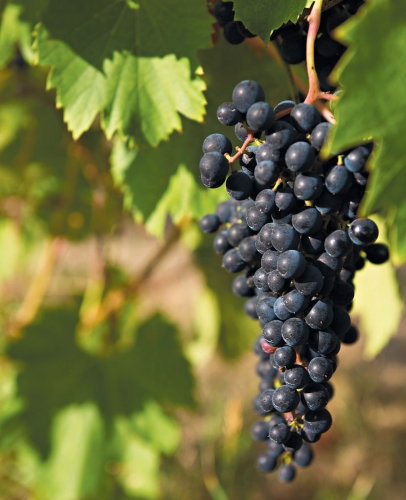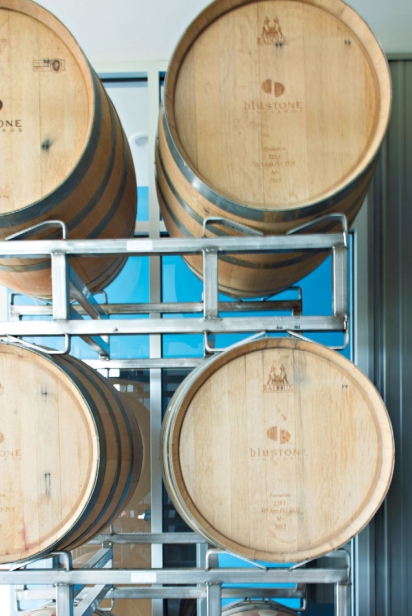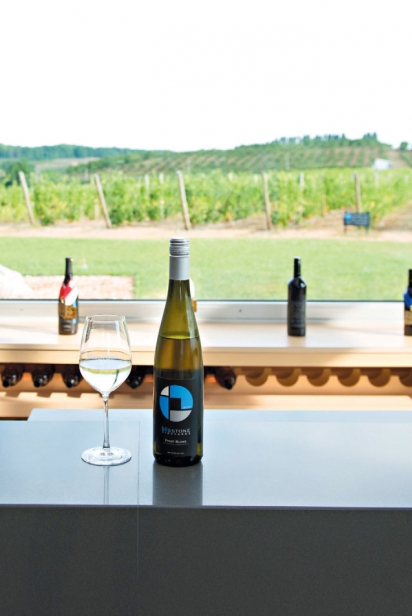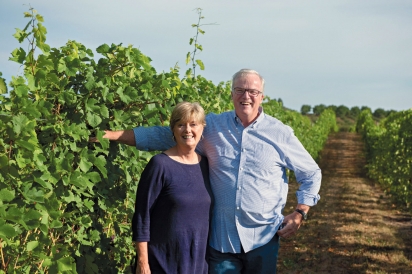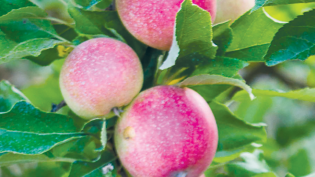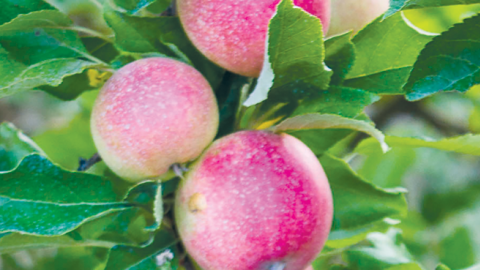Blustone Vineyards: A Gift of Nature
Tom and Joan Knighton, owners of Blustone Vineyards, first fell under the spell of the Leelanau Peninsula about 30 years ago, on a trip “up north” from Chicago, where they were living at the time. The allure of the area took hold of them, and they ended up coming back again and again before finally deciding to build a vacation getaway near Leland in 2000. But that soon turned into a permanent residence, and eventually—like the unexpected delight of coming upon a rare Leland Blue stone along the Lake Michigan shoreline—they found themselves in the midst of a new and exciting chapter in their lives— one for which they had, unknowingly, been preparing for a very long time.
“Ever since we got married, Joan and I have traveled a lot, and somehow, we always gravitated to places where people grow grapes and make wine,” says Tom Knighton. “I don’t really know why— maybe it stemmed from our love of good food and wanting to enjoy it with good wine. We have traveled in Provence in France and Napa Valley in California, in a lot of wine regions in Australia, and many other places. And on those travels, we found ourselves not just being interested in the wine itself, but in the experience of the wine and how people connect to wine.”
When the couple moved to Leland, they sought out and got to know people in the Northern Michigan wine industry. “We started to look at what was happening here, and we saw some really good things,” he says. “And one day I said to Joan, ‘You know, I think this is the kind of thing that we could do, and do well, and do distinctively.’ Our passion to become involved in wine growing and winemaking and learning more about all of it just kept getting stronger, to the point where I thought, ‘If we don’t do this, I think I’ll look back on my life and regret it.’”
That was the beginning of a new journey that the Knightons now feel was their destiny. “When people ask me why we would take the risk and invest the resources required for getting into this business,” says Knighton, “I tell them there were three things that occurred: There was a passion that led to a purpose that led to a promise.”
A fourth “p,” pragmatism, compelled them to approach their new venture realistically, however. Knighton sat down with legendary Leelanau Peninsula winemaker Larry Mawby, asking for his advice: “I said, ‘Larry, before I start writing big checks, you’ve just got to give me the good, the bad and the ugly about being in this business. I want to go in with my eyes wide open.’ And Larry said, ‘You know, if you have romantic notions about being in the wine business and waltzing through your vines, just run away from it as fast as you possibly can. The reality of it is you’re going to spend 10 percent of your time growing grapes, and about 10 percent of your time making wine, and about 80 percent of your time selling wine. So unless you are committed to the people side of the business, don’t even get near it. You’ll just get frustrated.’ And the good thing for us is that that played into what our strengths were.”
Knighton’s experience as a global business consultant was one of those strengths. “There are two areas of consulting that I’ve done all my life,” he says, “and they are both related to the ‘people side’ of business. One is leadership and organizational effectiveness. The other is a discipline called customer experience management.” [Note: He actually authored one of the first books written on the latter subject]. “So that was a key piece that said maybe we could make a go of this.”
Passion. One down, two to go. Tom and Joan still needed to zero in on the other elements— their purpose and their promise.
“We asked ourselves, ‘What are we here for?’” says Knighton. “And we boiled it down to a purpose that is about realizing potential. That we’re here to be stewards of the land we’re part of and to help it realize its potential. To realize the potential of our staff. To realize the potential of the fruit, the wine we make—we want it to be the best it can be. To realize the potential of the relationships we form with the people who come and visit us. And to realize the business potential that’s here. That purpose became our driving force.”
And the final piece—the promise?
“From the very beginning, we’ve believed that our brand is a promise,” says Knighton. “Our brand was present before anything else was created, and its promise is that we will make wines that will be respected nationally, with an experience that causes our customers to create a deep connection with our people, our product and this place.”
The brand even informed the land that the pair eventually purchased for their winery. They looked at many different properties, but when the one on which Blustone now sits became available in 2010, they loved the fact that it was just off M-204, but not right on M-204. “The placement of the tasting room in 2012 was a derivative of the brand, too, because we wanted people to be really connected to the vineyards,” says Knighton. “That’s the reason we situated it in the middle of the them, at the highest point on the property, and why we put in 360-degree windows.”
Mission accomplished. The connection is immediate as you drive up steep, gracefully winding Sylt Road past row after row of robust-looking grapevines, and only intensifies upon entering the industrial-modern yet somehow still cozy wood, metal and glass structure that houses the tasting room.
“It’s all about the grapes and the terroir,” says Knighton. “And we actually didn’t realize how beautiful this property was in the beginning, because although there were about eight acres of grapevines already planted on it—Riesling, Pinot Noir and Pinot Gris—it was actually in the process of being transformed from a cherry orchard into a vineyard. Everything you now see from our windows was all cherries. But one nice thing about having those eight established acres of grapes was that we could make wine the first year we owned the property. And the other nice thing is that we now have Pinot Noir vines on the property that are 13 years old. They are deep and seasoned and very prolific, so we’re making some outstanding wine out of them.”
Right away, most of the remaining cherry orchards, which were quite old, were removed to accommodate new vineyards. The last one to go—in 2017—is now a ten-acre open field, clearly visible behind the tasting room, which is being prepped for planting more vines next year. With that they will have 18 acres planted here, plus another three acres north of Leland.
Understandably, a lot of people ask about the origin of the name the Knightons eventually chose for their vineyard: Blustone.
“We wanted to connect it to something that was distinctly local,” says Knighton. “Our home is on Lake Michigan, and we thought about the experience of walking along the shoreline and finding a Leland Blue stone amongst all the other rocks—it’s rare enough now that it’s kind of an exciting moment. And that became the essence of our brand: wanting to create an experience with our wines that is just as uniquely pleasurable and unexpected. If you look at our labels, which were designed by our oldest son [they have two], they are all done in a combination of blue, white and gray. And particularly if you look at our Chardonnay label, which was our first one, it depicts the beach—it’s all about the different colors of rocks, with the blues popping out of the grays and whites. Everything we do has some tie back to who we are.”
Yet another unexpected and happy surprise— also related to stones—greeted them when they started working the land: They discovered that glacial activity from the last Ice Age had etched itself on the Blustone property in such a way that gave it an affinity with the vineyards of the very wine-friendly Alsace region of France. In Alsace, it’s often said that you can walk 100 meters (about 300 feet) in any direction and find different soils, or terroir. Thus, although the Alsatian viticultural region is relatively small, the variety of different grapes that thrive there is quite remarkable.
And so it was with Blustone. “Here, just on our 40 acres of property, depending on where you touch it, we actually have three different terroirs,” says Knighton. He makes a sweeping motion with his hand in one direction. “If you look over there, the second hill over and a bit of the surrounding area is basically granite over limestone.” Then, motioning to a closer plot, “This hump is all clay. And if you go up to the northeast corner, it’s rich sandy loam, which is characteristic of a lot of the vineyard land in Leelanau County. All three of those are good grape-growing soils, but they all provide different growing conditions for the grapes and impart different flavors to the wine.”
Those particular soils echo some that are found in Alsace, too, so some of the same grape varieties that grow well there also do well at Blustone, including Riesling, Pinot Gris, Pinot Blanc, Gewürztraminer, Pinot Noir and Chardonnay.
In spite of all the similarities, Knighton says that the connection to Alsace wasn’t intentional. “We didn’t go about saying, ‘We’re going to make great Alsatian wines.’ We started playing with them because they grow well here and we enjoy them. We were more about, ‘What do we grow on the 45th parallel?’ We’re always fascinated by the fact that there are wine regions all around the world on that latitude.” [Note: Alsace lies just 200 miles north of the 45th parallel.] “So although I wouldn’t say that the Alsatian varietals were a focus in the beginning, it is an area of wine that people pay attention to and like about us, and we have certainly nurtured that.”
Part of the reason for choosing to grow certain grapes was to have a few that were unique—not just the same as everyone else had, says Knighton. “Take our Pinot Blanc—we experimented for a couple of years with a little bit of it, but it took to the vineyard so beautifully, and our customers liked it so much, that we ended up expanding it pretty significantly.”
The Riesling and Pinot Noir grapes grown on the Blustone property are the ones most affected by the granite and limestone terroir present there. “They display the highest degree of minerality,” says Knighton, “because they’re growing in rock. And the quality of the wines we’ve been able to produce from this vineyard is amazing. Our Rieslings—dry, sparkling and late harvest—have never done less than a gold medal in international competition. As for the Pinot Noir, it’s one of the most sensitive wines to terroir—to soil and weather conditions. We’ve been very fortunate to have had as consistent a run with it as we have. It has become one of our signature wines, and in the fall, we’ll be releasing our first Pinot Noir Reserve. We held back some of our best barrels and left the wine in them for another nine months. It’s really yummy now.”
Blustone makes its wine in a nearby custom crush facility that also makes wine for several other local wineries and share a winemaker. “It’s definitely a team effort, though. I choose all of the barrels that our wine will be aged in—with the help of the people who advise us, of course—and together we make the decisions on what kind of character we’re trying to bring out in our different wines, depending on what they’re showing that particular year. We like to let the wines express themselves and not force them in any direction. There’s a lot you can do with barrel selection, and we always try to have 30 percent new oak so that there’s that freshness in the wine.”
John Molenhouse, Blustone’s vineyard manager, has been on board since the very beginning. “He has a master’s degree in biology from the University of Michigan and has done continuing studies at Michigan State,” says Knighton. Next year will be the first year that we have turned the entire vineyard over to him. He has just demonstrated an amazing ability, in terms of both commitment and knowledge, and he is ready.”
During the summer, Blustone hosts a variety of events, including wine dinners, Foodie Fridays and Bluegrass at Blustone, but they all end around Labor Day because fall is so busy otherwise. Come wintertime, the winery turns to cross-country skiing and snowshoeing events, including one called Torches and Tracks.
“It’s a really fun family evening, where we light up the vineyards at night with glow sticks, and you can go snowshoeing through them,” says Knighton. “Afterward, the adults can do wine tasting, and we have a hot chocolate bar for kids.” More plans for connecting to the wine-loving public are on the horizon: The kitchen is being upgraded so that they can offer more culinary experiences with their wine.
The elusive Leland Blue that inspired the name and essence of the Knightons’ vineyard and winery began as slag, a byproduct of an iron ore smelting operation that existed in Leland from 1870 to 1875. It was considered worthless and was disposed of by dumping it into Lake Michigan. Who could have predicted that the effects of time, weather and water would transform it into something of rare beauty and value? Much like the way those same elements (albeit with a little help from humans) transform the combination of granite, limestone, dirt and vines at Blustone Vineyards into yet another thing of beauty and value—a magical elixir called wine. In that context, the name couldn’t be more appropriate.
IF YOU GO:
Blustone Vineyards
780 N. Sylt Rd., Lake Leelanau
231-256-0146 • BlustoneVineyards.com


